Did you know there are currently over 190 registered purebred dogs, according to the American Kennel Club (AKC)? Each dog is listed in a designated group dependant on what the pooch was bred to do.
Today, we are going to explore the “working” dog, what it is, and the top 10 of the most popular in this category.
We’ve “worked like a dog,” so let’s get started!
What is a Working Dog?
Working dogs are more than pets or a companion; these canines have been bred and trained to do a specific job. There are seven main types of working dogs. They include;
Service - trained to help people with disabilities (hearing impairment, loss of sight, mobility, and medical assistance).
Therapy - used for emotional support for hospitals, schools, or individuals that have psychological issues (depression, stress, phobias, etc.).
Police K-9s - trained for police work in chasing down and holding criminals, protecting their handlers, detection of bombs, drugs, etc.
Military - trained for bomb detection, trackers, scouts, search and rescue.
Detection - the highly sensitive nose of some breeds are utilized in sniffing out explosives, drugs, human remains, and more.
AdvertisementSearch and Rescue - when someone goes missing, these working dogs can track a trail, perform avalanche rescue, or finding human remains.
Herding - these dogs instinctively know how to keep sheep, cattle, and other livestock in line.
Now that we know what these “specialized” pooches can do let’s “dig” into the top 10 list of the most popular working dogs.
Top 10 List of the Most Popular Working Dogs
1. St Bernard
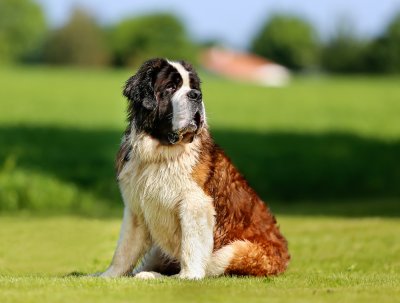
This large muscular, furry pooch was initially used to guard the grounds of a Switz hospice by the same name (Saint Bernard). And of course for mountain rescue in the Alps for those stuck in the cold snow. Today, this friendly, gentle, and lovable working dog enjoys the comfort of homes all over the world. Although the St. Bernard is a calm indoor pet, it will enjoy romping in a spacious yard, or the park. This breed is not aggressive by nature, but due to its large size and generous coat, it may track in dirt, debris (and some drool).
- Weight: 120 to 180 pounds
- Height: 26 to 30 inches at the shoulder
- Lifespan: 8 to 10 years
- Bred to Do: Rescue, guard, draft, and herd
Did you know the St. Bernard never carried a barrel of brandy around its neck? That’s a myth!
2. Newfoundland
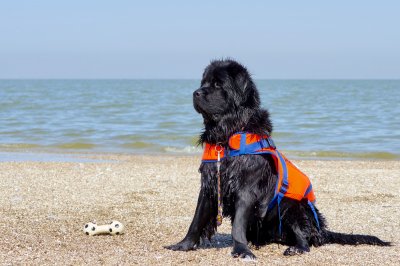
There’s nothing dainty about this large, strong working dog. It was originally used to pull fishermen’s heavy-laden nets from the water, as well as haul wood from out of the forest. Today, the Newfoundland (Newfie for short) is still capable of both land and water work (it’s a powerful swimmer). It’s a gentle, mellow dog with a sweet temperament that loves children and is eager to please. The Newfie is also very intelligent, so be sure he still has a “job” to do to keep him from becoming too bored.
- Weight: 100 to 150 pounds
- Height: 26 to 28 inches at the shoulder
- Lifespan: 9 to 10 years
- Bred to Do: Pull nets for fishers and haul wood.
Did you know the Newfoundland dog has been dubbed a “nanny dog” because of its affinity for children?
3. Rottweiler

There are two ways the Rottweiler can be perceived, as a gentle goofball, or one scary pooch, which is all very dependant on its pet parent, and personality. Although this formidable canine is a loving and devoted family pet, it will take time to "warm up" to strangers. You will also want to make sure your Rottie still has a job to do, so it doesn't become bored or depressed.
Because of its suspicious nature, Rottweilers will need to have focused, consistent training with early socialization, especially around children and other pets. Additionally, Rotties can be sensitive animals, so leaving it penned, or tied outside alone for long hours will not work well with this breed.
- Weight: 22 to 27 inches at the shoulder
- Height: 85 to 130 pounds
- Lifespan: 8 to 11 years
- Bred to Do: Herd, guard, haul, police work, and search and rescue.
Did you know Rottweilers served in rescue missions after the 911 attack? They searched through the rubble alongside other breeds like Labrador Retrievers and German Shepherds!
4. Doberman Pinscher
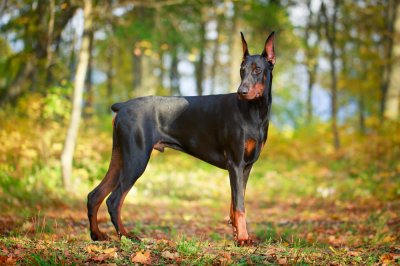
With the Doberman's sleek, athletic build and smooth coat, it looks more like an aristocrat than a member of the working dog family. Despite its "royal" appearance, the Dobie is very intelligent and highly energetic, so no lazy pet parents allowed for this breed! It's both these qualities that make the Doberman Pinscher an excellent candidate for police work, military, or guard-duty.
As a family pet, the Dobie shouldn't be left alone for long hours, as it wants to be a part of a family unit. Because of this breed's genetic make-up, don't be surprised if your Doberman takes on the role of guard dog in your home. It's also a quick learner, so take advantage of this and teach your canine companion obedience and some tricks!
- Weight: 60 to 80 pounds
- Height: 24 to 28 inches at the shoulder
- Lifespan: 10 to 13 years
- Bred to Do: Police work, military, guard, therapy, service, and search and rescue.
Did you know a Doberman Pinscher named Kurt is a war hero? He warned his troop of approaching Japanese soldiers in the Battle of Guam in 1944. Kurt saved many lives on that day!
5. Bullmastiff
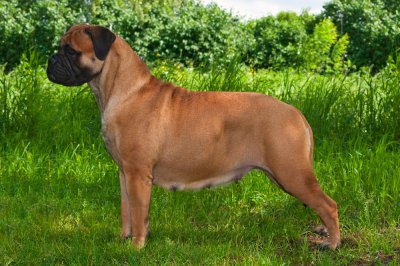
Despite the tough Bullmastiff exterior, its an affectionate and gentle family member. But don't let its love-bug home attitude fool you, if a stranger enters into the picture, your Bullmastiff will likely go into protection-mode, as the breed is suspicious of strangers. With a generally easy-going nature, the Bullmastiff makes a good pet for families with older children.
This breed isn't a pushover and may give you some "attitude" when it comes to training; early socialization and puppy classes are recommended. You may also consider buying your Bullmastiff a bib, as they do drool and slobber quite a bit. They are also known for their loud snoring, so be aware when sharing a room with the Bullmastiff.
- Weight:110 to 130 pounds
- Height: 24 to 27 inches at the shoulder
- Lifespan: 7 to 9 years
- Bred to Do: Guard
Did you know the Bullmastiff was trained not to bark or bite, but rather to track, pin, and hold thieves for wealthy landowners?
6. Great Dane
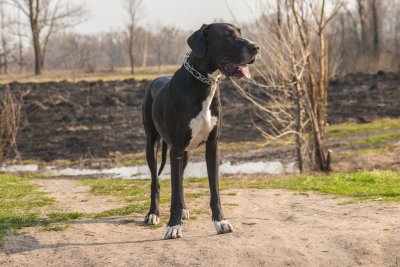
Known as the "gentle giants" of the canine world, the Great Dane is one dog that will make you take pause. Not just because of its sheer size, but also because this pooch exhibits a kind and gentle spirit. Danes are excellent with children and other pets, but of course, because of its gigantic build, pet parents will need to watch small children around this family member.
This noble pooch is an affectionate animal that loves people, even strangers. The breed outwardly shows love by nudging his favorites with his massive head. Despite his size, the Dane doesn't eat as much as one would think and only needs a daily walk around the block to meet his needs.
- Weight: 110 to 175 pounds
- Height: 28 to 32 inches at the shoulder
- Lifespan: 10 to 14 years
- Bred to Do: Hunter, protector
Did you know the Great Dane was most likely bred to hunt wild boar? Its massive build and bravery made it a formidable hunter back in the day.
7. Siberian Husky
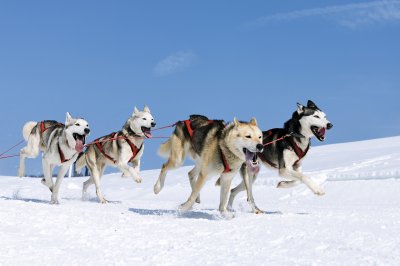
With a wolf-like appearance, the Siberian Husky will get respect wherever it goes. That is until it melts in your arms with big furry snuggles! This breed is very affectionate and will not make a good watch dog because it rarely barks. The Siberian Husky puppy will need early socialization and puppy classes as this breed can be stubborn and difficult to train.
Since the Siberian Husky is a pack dog, it will need a pet parent to assume the role of pack leader. Consistent training using positive reinforcement is always best, but be aware that your Siberian may test the limits of your "leadership" role.
- Weight: 35 to 60 pounds
- Height: 20 to 23,5 inches at the shoulder
- Lifespan: 12 to 15 years
- Bred to Do: Pulling
Did you know the Siberian Husky is born to be a sled dog? They tolerate the cold and can run long distances on very little food or warmth.
8. Akita
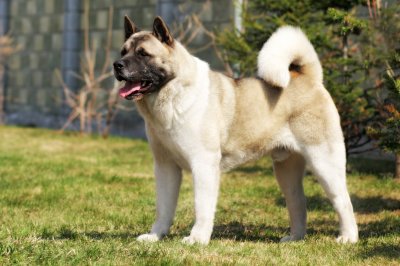
With a lineage firmly planted in hunting and guarding, it's not a mystery as to why the Akita isn't easily intimidated or won't back down from a challenge. These qualities make this breed a great family protector and loyal guardian. However, it can also be on the stubborn side and is very wary of strangers. These are excellent qualities for a watchdog, but if you want to keep an Akita as a family pet, you will need an experienced pet parent to keep the Akita happy and healthy.
As a family pet, the Akita is alert, curious, and very loyal. The breed does tend to show aggressiveness towards other canines (especially of the same sex), so it should be kept in a one-dog home. Along with a dedicated, experienced pet parent, the Akita also needs an active one. A bored Akita can translate into a destructive Akita!
- Weight: 70 to 130 pounds
- Height: 24 to 26 inches at the shoulder
- Lifespan: 10 to 12 years
- Bred to Do: Protect
Did you know the Akita was bred to hunt elk, boar, and bear in the snowy mountainous region of Japan, Odate, and Akita? They were also used to guard royalty.
9. Great Pyrenees
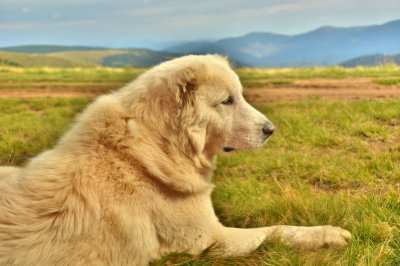
Who wouldn't want the lovable, furry Great Pyrenees as a family companion and loyal friend? This breed was born to protect and guard, whether that be your children, family pets, the lawn, your shoes, or even the backyard tree, this pooch is always on duty. The Great Pyrenees is intelligent, and affectionate, always willing to take a hug or give a sloppy kiss in return.
The Pyrenees is an active breed that enjoys daily romps in the yard or playing with his doggie pals in the park. It loves children and even makes an excellent therapy pet for hospitals or nursing homes, that is, once he is trained. You may also want to take note that the Pyrenees is a vocal pooch and will bark when it hears (or thinks it hears) any noise that should be paid attention to.
- Weight: 85 to 160 pounds
- Height: 25 to 32 inches at the shoulder
- Lifespan: 10 to 12 years
- Bred to Do: Guarding, herding
Did you know the Great Pyrenees was bred to be a livestock guardian for farmer's flocks residing in the Pyrenees Mountains of Europe?
10. Boxer
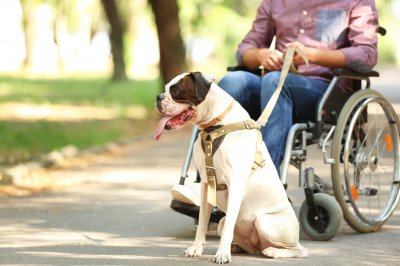
Despite the Boxer's past, this breed will take love over fighting any day. It thrives on human companionship and is the happiest when included in the family's daily activities. The Boxer has a special heart for children and is very patient and kind with the little ones. Although you may have to reign in the Boxer's natural exuberance when around its favorite humans - when we say "exuberance" we mean leaping and jumping up when his beloved humans are back!
Because of their natural affinity for people, the Boxer makes an excellent therapy or service dog. However, don't let his laid-back persona fool you; this breed is an active pooch that thrives when kept busy. Never leave a bored Boxer alone in the home, as you could return to torn cushions, or tossed garbage pails.
- Weight: 60 to 70 pounds
- Height: 21 to 25 inches at the shoulder
- Lifespan: 10 to 12 years
- Bred to Do: Cattle dogs, police, guard, and guide
Did you know the Boxer is a powerful and brave breed that was once used as war dogs and for bull baiting?
Working Dog Breeds & You!
The working dog category has several members, all of which are dogs bred with a job in mind. Before you bring a working dog into your family, be sure to thoroughly research the pedigreed to ensure you are ready for what this dog entails. All canines are much more than their outward appearance, so do both yourself and your prospective pet a favor and know what will be expected from you as the right pet parent for the working pooch.